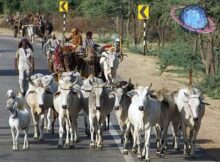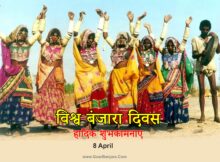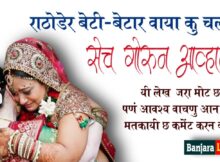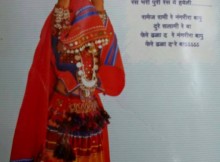Diwali is the festival of hindu but it is also celebrated by Gaur mati in every part of the state where our people are in existence .Diwali is the festival of light with full of zoom and people light up their houses and shop in dazzling manner. During this festival people of our Ghor samaj dedicate their offering to the forefather and worshipped with them and even to their kuldevi. The system created by the Pandit are following by the general candidate. But there is a speciality in Gaur tradition where they also accustomed for worshiping of the goddess they have a tradition of offering Dhabukar in the name of ancestors.
In Maharashtra there is a custom of offering food and worshipping the ancestors in Marathi month of Bhadrapad. In the same manner the ancestors are remembered in every household of the Tanda on the occasion of Diwali and Holi. Favourite food items of the ancestors are prepared and its five portions are put into holy fire. The court yard of the house is cleaned and water is sprinkled there. Water is also sprinkled in the place where the cattle are rested to purify the area. This custom is known as Dhabukar. For the ancestor who is known to have had habit of drinking some liquor /beedi is kept in front of their photo or gore. This is known as ‘Dhar Deyar.’ On the first day of this festival i.e. black day of the Kali Mata, a goat is sacrificed and the goddess is worshipped. Young girls, with lamps in their hand go to each household in the night and take blessings of the elders. The next day the girls perform the Godhan Pooja and also observe fast on that day. It is really wonderful to note that our banjara community is also evolved in diwali festival but it is really some what different because our people do not call priest from Brahmin culture because we have our own identity .
Gor Banjaras are basically worshippers of Nature. They treat the Sun, Earth, Fire, Wind and Water as gods and worship them. The tribe, which worships the birth giver i.e. ‘pitru’ and the goddess might have been following the Vedic religion. Instances of Gor Banjaras first adopting the Buddha religion during the time of Gautam Buddha have been found.In general course young girl from Banjara community do mera to their relative people to whom she can do marriage as per gotras and demand money because it is the traditions and habit that come into practice that day people cannot refute to the girl .In gor mati while offering the mera they sang in this style varesh diwali kor diwali mama tohna mera .Actually, the mera word have been twisted in different area likewise you may find in Mumbai where our Gormati spell meriya .The meri word has across from Christianity particularly in Bandra where one our gor brethren along with his girl has visited to the catholic church while his son had set about sick and it was the holy father who was blessed him and given supper whilst they were celebrating the function of MERIAMMA during the period of diwali .At last the sick boy was healed and the girl has overwhelmed with joy and demanded to her father that my brother has recovered with the worship of MERIAMMA.
So i need gifts for my pocket expenses for purchasing some article thereafter ,the father has allowed to his son for gifting the money to his sister. Accordingly the tradition has started during the period of diwali and our community people has followed the traditions in every corner of the area where our people stayed in the abundant manner. In similar manner the Christians also celebrate the Christmas festival in the month of December festival by lighting up candles and letting fire crackers off.It is right that the festival celebrate by the hindu in a jubilant manner,but, at the same time it is too true that the diwali is not the festival of Gaur Community. As such the actual festival is Teej ,Seetla,Tulja,Ugadi i.e Gudipadav Dussera and colourful Holi where our community people have some special attraction for celebrating this festival. But is the modernization where people started to take the new tradition being the Brahmin community has forcibly made us Hindu for the sake of the legal epoch.For each and every festival the sarpanch i.e Naik was the sole authority to issue the permission for starting the festival. It is very much interesting to know that why the people do mera in our gor community .As the above synopsis is not adequate ,therefore, every Gaur community is very much interested to know the factual position how it is derived the tradition of Mera .
Once the pala empire was ruled his dynasty during the period of 1100 century .He was a Buddhist imperial power in classical india.The word pala meaning protector in Bengali .The monarchy was centred on eastern regions of the India subcontinent .Pala empire was divided into separate Bhuktis Provinces .Bhuktis were divided into Vishayas (Divisions and Mandalas District.As the area was divided into various part therefore the pala empire has maintained his administrative office by carving into smaller units Khandala ,Bhaga ,Arvitti,Chaturaka and pattaka .In addition to this total administration covered widespread region from the grass root level to the imperial court for managing the territory .During these period the pala copperplates mention following administrative post,Rajanyaka ,Ranaka (possibly subordinate chiefs),Samanta and mahasamanta (vassalkings)Mahasandhi vigrahika (Foreign ministers),Duta (Head ambassador ,Rajasthaniya(Deputy),Aggaraksa(ChiefguardSasthadhikrta,(Taxcollector),Chauroddharanika (Police tax),Shaulkaka (Trade tax,Dashapardhika (collector of penalties).To get the additional income from the river wave separate toll had provided for the collecting the tax toward the river crossing .Mahakaspatalika(Accountant )Jyesthakayastha (Dealing documents),Ksetrapa (Head of land use division )and pramatr(Head land measurement mahadandanayaka or Dharmadhikara(chief justice mahapratihara ,Dandika ,Dandapashika ,Dandahakti(Police forces) and Khola (secret service).Agricultural post likes gavadhakshya(head of dairy farm) Chhagadhyakshya (Head of goat farms), Meshadyakshya (Head of sheep farms),Mahishadyakshya(Head of Buffalo farms)and many other like vogpati,vishayapati ,Shashtadhirkuta,Dauhshadhanika,Nakadhyakshya.
The pala empire was ruled their kingdom for the period of 100 year and they adopted the buddhisim.As we were closer to the Buddhism therefore our gaur community has not followed the Hinduism as a result , we have maintained the distance of Brahmin people and stayed in the caravan and tanda .For gaur marriage we have never taken the service of Brahmin (Poojari) but we were relying upon our priest who is called bhagat. Basically, the Gaur (Ghor) people were following the system of khola as a result gaur people started their system and worship their ancestor a day before diwali in the dawn of new lunar month .(New amavaysa). Accordingly our people have pursued their philosophy where they have sacrificed the goat in the ceremony. As a atheist and non believer of hindu god our people were very much dedicated to Mari amma for which our bhagat mean priest use to forecast the future and say to our people to sacrifice the goat in favour of our TULJA Devi or mari amma . Once upon a time all the cattle were dying in the village and our people were believed that mariamma was annoyed and not satisfied with us then they followed the system of khola rule and sacrificed the goat. Later on all the sin was eliminated from the village and all the cattle were inhaling and healthy in the vicinity of that area. Hence we were not hindu but gor people followed the tradition and style of khola those who are actually belong to khola lineage during the pala dynasty.
As you are well aware that hindu people have created a lot of restriction to their people and for that we cannot exemplify the paradigm in this text but damn sure that some of the important perceptual or scriptural law and social setting had boosted the background of picture of the law in action those times. Needless, it is significant to note that diwali come mera occurs in our gor community particularly for young girl those who are awaiting and counting the day to get the some handsome gifts. As the festival is full of light,then desperately one have to ignite the light in the house while the sarpanch of the village order to light the lamps in the evening .Then the task of unmarried girls has to play the vital role in the tanda to carry a lamp(Dhakni) and jaggery along with them .As the sarpanch is the head of the village member therefore all the young girls take the blessing and sing a folk song which is even practice today date . Essentially, the song is dedicated to the village benevolent purpose and it has stood for the Diwali has come at once in a year and you are Nayak my Bapu pleases bless us on this auspicious occasion. After the girl mates goes to cattle shed where the cow are rested then they praise to the cow and take the blessing by expressing that Varshe Dahde Ree Khor dawali Gawdi Yaadi Tona mera .In English we may emphasis that the Diwali comes once in a year. Oh, my dear pretty cow, I bow in front of you. Please bless our Tanda and us. Subsequently, all the aspiring young girl visit to each household and relative house for obtaining the blessings .Nevertheless, on the next day the cow dung which is settled in the courtyard is kept as it is .The primary ground for not getting rid of the cow dung is that all the community people those who are worshipping to their ancestors offered in the early dawn. All the god will be offered sweet which is made up of dhaliya having ghee in the items. All the girls who are young and pious are visiting at the farms and jungles in the afternoon where they can get collect plentiful of flowers. Cowdungs are mainly prepared in front of Nayak house and they start worshipping the cows and sung the song in cluster of groups and praise the cows this is the culture of Gaur community.
With Regards,
ArPravin Naik
Social workers









